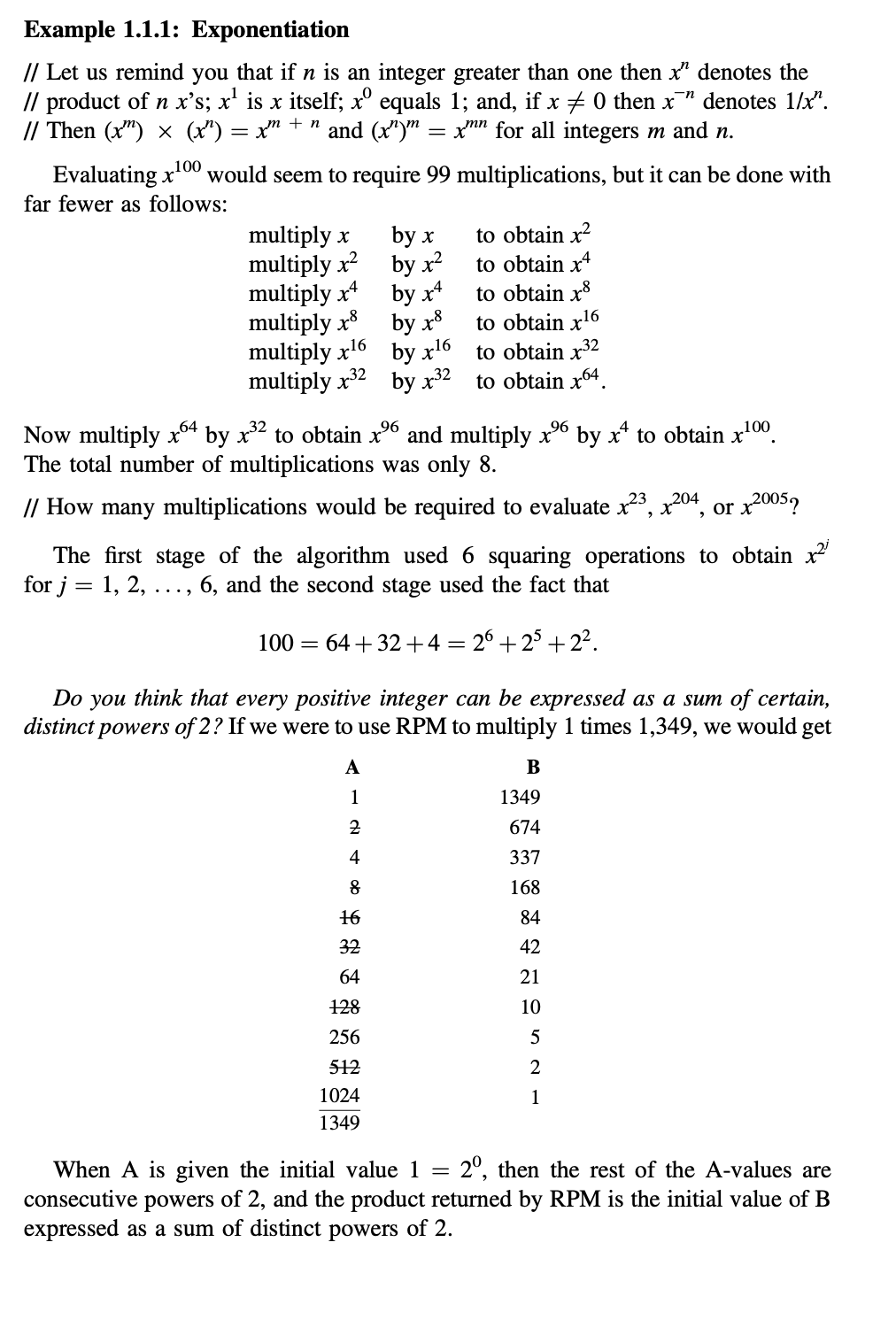it is shown that the number of multiplication needed to compute x100 is 8. Using the same method, how many multiplications are needed to compute x111?
it is shown that the number of multiplication needed to compute x100 is 8. Using the same method, how many multiplications are needed to compute x111?
Algebra & Trigonometry with Analytic Geometry
13th Edition
ISBN:9781133382119
Author:Swokowski
Publisher:Swokowski
Chapter5: Inverse, Exponential, And Logarithmic Functions
Section5.6: Exponential And Logarithmic Equations
Problem 64E
Related questions
Question
it is shown that the number of multiplication needed to compute x100 is 8. Using the same method, how many multiplications are needed to compute x111?

Transcribed Image Text:Example 1.1.1: Exponentiation
// Let us remind you that if n is an integer greater than one then x" denotes the
// product of n x's; x' is x itself; x° equals 1; and, if x + 0 then x
// Then (x") x (x") = x" + " and (x")" = x"n for all integers m and n.
denotes 1/x".
Evaluating x'
100
would seem to require 99 multiplications, but it can be done with
far fewer as follows:
multiply x
multiply x? by x²
multiply x
multiply x by x3
multiply x16 by x16 to obtain x32
multiply x2 by x2 to obtain x64.
to obtain x?
to obtain x4
to obtain x
to obtain x16
by x
by x4
Now multiply x4 by x" to obtain x6 and multiply x by x* to obtain x100.
The total number of multiplications was only 8.
// How many multiplications would be required to evaluate x23, x204, or x2005?
The first stage of the algorithm used 6 squaring operations to obtain x?
for j = 1, 2, ..
6, and the second stage used the fact that
100 = 64+ 32 +4 = 26 +25 + 22.
Do you think that every positive integer can be expressed as a sum of certain,
distinct powers of 2? If we were to use RPM to multiply 1 times 1,349, we would get
A
В
1
1349
2
674
4
337
168
16
84
32
42
64
21
128
10
256
5
512
2
1024
1
1349
2°, then the rest of the A-values are
When A is given the initial value 1
consecutive powers of 2, and the product returned by RPM is the initial value of B
expressed as a sum of distinct powers of 2.
%3D
Expert Solution
This question has been solved!
Explore an expertly crafted, step-by-step solution for a thorough understanding of key concepts.
This is a popular solution!
Trending now
This is a popular solution!
Step by step
Solved in 2 steps with 1 images

Recommended textbooks for you

Algebra & Trigonometry with Analytic Geometry
Algebra
ISBN:
9781133382119
Author:
Swokowski
Publisher:
Cengage

Linear Algebra: A Modern Introduction
Algebra
ISBN:
9781285463247
Author:
David Poole
Publisher:
Cengage Learning

Trigonometry (MindTap Course List)
Trigonometry
ISBN:
9781337278461
Author:
Ron Larson
Publisher:
Cengage Learning

Algebra & Trigonometry with Analytic Geometry
Algebra
ISBN:
9781133382119
Author:
Swokowski
Publisher:
Cengage

Linear Algebra: A Modern Introduction
Algebra
ISBN:
9781285463247
Author:
David Poole
Publisher:
Cengage Learning

Trigonometry (MindTap Course List)
Trigonometry
ISBN:
9781337278461
Author:
Ron Larson
Publisher:
Cengage Learning

Algebra for College Students
Algebra
ISBN:
9781285195780
Author:
Jerome E. Kaufmann, Karen L. Schwitters
Publisher:
Cengage Learning